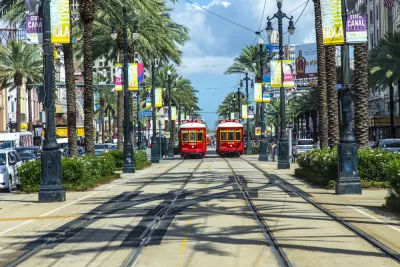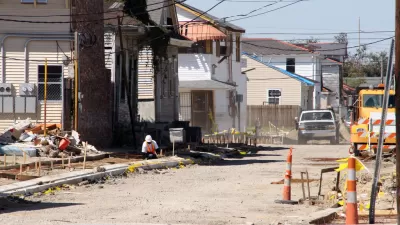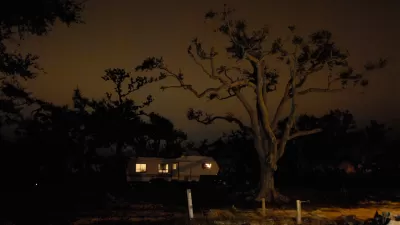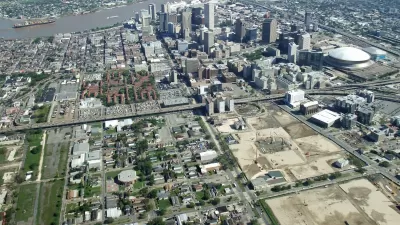“A narrative of rebirth, reform and success that coexists with a narrative of stasis, failure and unrealized dreams.”

The New York Times presents a multimedia foray into the redevelopment of some of New Orleans’ most devastated neighborhoods after Hurricane Katrina. The post-hurricane devastation presented a lucrative “blank slate” for entrepreneurs, real estate developers, transplants and immigrants. But for many long-time residents, the displacement was permanent, and the rich cultural heritage dissolved into history.
Treme, the "birthplace of jazz" is whiter; Mid City is more Hispanic; and the Lower Nine is all but deserted. According to the Times, in the Central Business District: "The start-up scene here is, to a great extent, a deliberate construct, built by a small, aggressive group of boosters who believe that this city, so careful to honor its past, must innovate its way to a future that isn’t so reliant on the old standbys of the oil, gas and hospitality industries."
Prior to the hurricane, there was already an effort underway to reduce concentrated levels of poverty by transitioning projects residents into voucher holders. According to the Data Center, the number of households using vouchers doubled in the five years before Katrina, and doubled again in the five years following. However, "the reliance on the private housing market to fill the affordable housing gap neglected to account for the post-disaster housing shortage." There are still thousands on the voucher waiting list. The Times feature includes a map that shows median rents have risen while median income levels have declined in neighborhoods all across the city.
The razing of project housing in favor of mixed-use, mixed-income developments is lauded by some as New Urbanist revitalization and others as gentrification. "But while in most cities gentrification is caused by a simple desire for prime real estate, in New Orleans the draw is the very culture that the resulting changes to the city is eroding," writes John Stanton. Indeed, with only half as many subsidized rental units available at traditional public housing rates, and a severe housing shortage all over the city, many neighborhoods have permanently lost pre-Katrina populations that had roots many generations back.
"Before the flood, the Tremé blocks just east of the Lafitte public housing projects and south of Claiborne Avenue were both close-knit and tough; the music flourished, but so did crime and blight. Joe’s Cozy Corner was where musicians met before their gigs in the French Quarter; it was also where 'Papa Joe' Glasper, the bar’s owner, shot and killed a man," the Times reports.
Hat tip to the NYTimes team: Campbell Robertson, Richard Fausset, Alexandra Garcia, Margaret Cheatham Williams, Andrew Blackwell, Tanner Curtis, Haeyoun Park, Rumsey Taylor, Derek Watkins, Josh Williams, Katy Reckdahl, and Ben Laffin.
FULL STORY: Ten Years After Katrina

Maui's Vacation Rental Debate Turns Ugly
Verbal attacks, misinformation campaigns and fistfights plague a high-stakes debate to convert thousands of vacation rentals into long-term housing.

Planetizen Federal Action Tracker
A weekly monitor of how Trump’s orders and actions are impacting planners and planning in America.

San Francisco Suspends Traffic Calming Amidst Record Deaths
Citing “a challenging fiscal landscape,” the city will cease the program on the heels of 42 traffic deaths, including 24 pedestrians.

Defunct Pittsburgh Power Plant to Become Residential Tower
A decommissioned steam heat plant will be redeveloped into almost 100 affordable housing units.

Trump Prompts Restructuring of Transportation Research Board in “Unprecedented Overreach”
The TRB has eliminated more than half of its committees including those focused on climate, equity, and cities.

Amtrak Rolls Out New Orleans to Alabama “Mardi Gras” Train
The new service will operate morning and evening departures between Mobile and New Orleans.
Urban Design for Planners 1: Software Tools
This six-course series explores essential urban design concepts using open source software and equips planners with the tools they need to participate fully in the urban design process.
Planning for Universal Design
Learn the tools for implementing Universal Design in planning regulations.
Heyer Gruel & Associates PA
JM Goldson LLC
Custer County Colorado
City of Camden Redevelopment Agency
City of Astoria
Transportation Research & Education Center (TREC) at Portland State University
Jefferson Parish Government
Camden Redevelopment Agency
City of Claremont





























